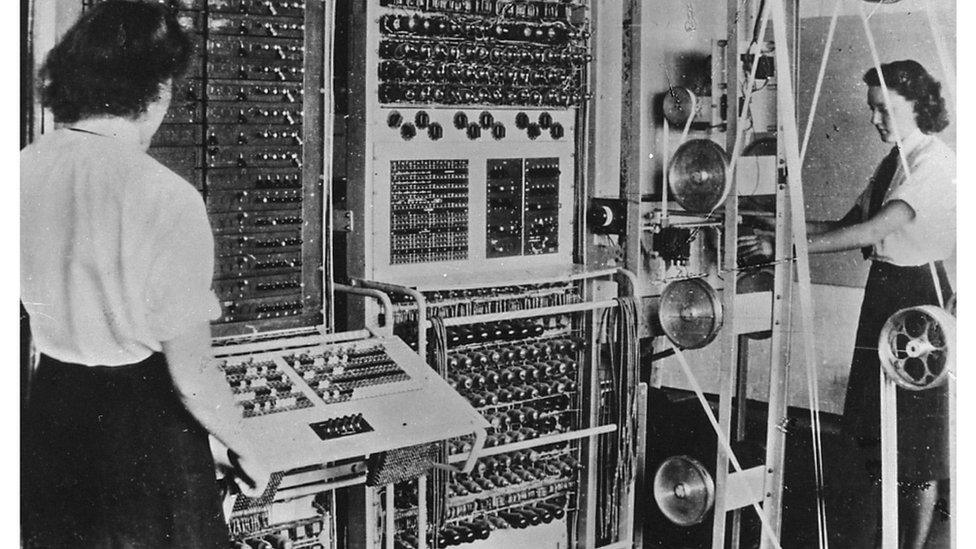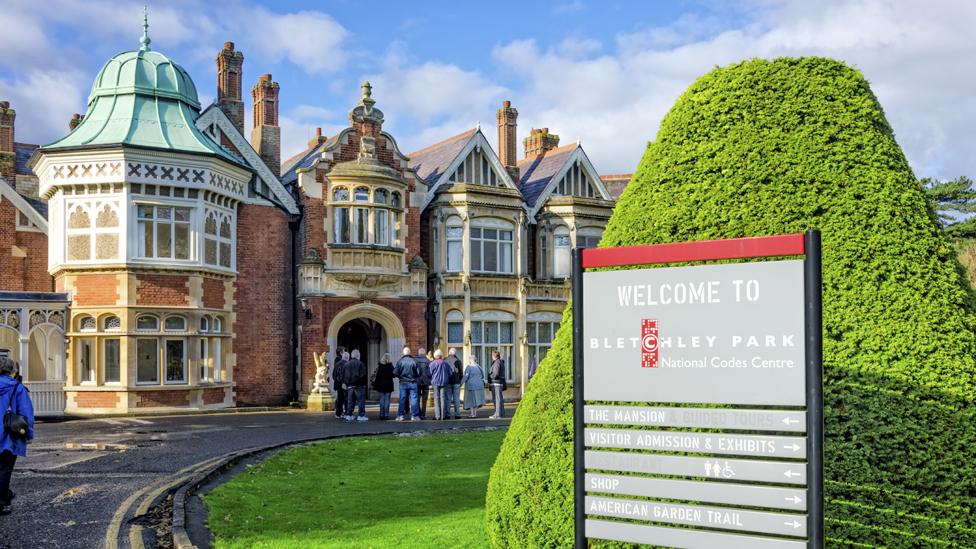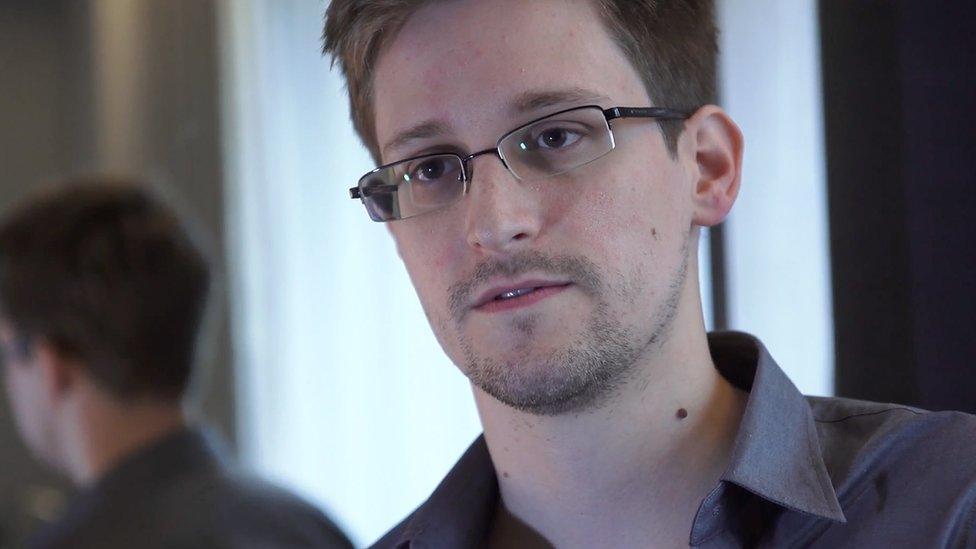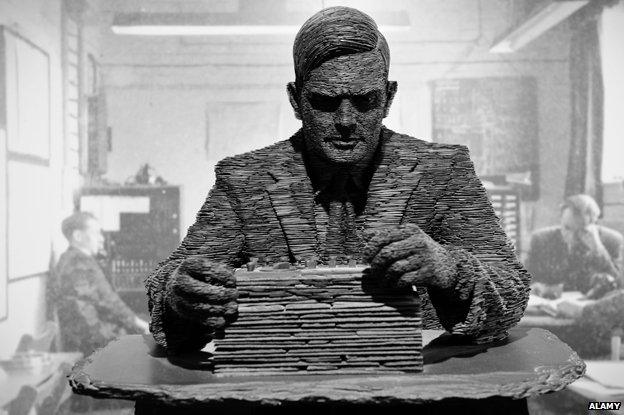How the British and Americans started listening in
- Published

A secret visit to Bletchley Park 75 years ago gave birth to an alliance between two British and US intelligence agencies which continues today.
It was late on 8 February 1941 when four Americans arrived at Bletchley Park. Black-out curtains made the mansion appear even darker. The journey of the four - known as the Sinkov mission after their leader Abraham Sinkov - had been stormy, dangerous and utterly secret.
Their arrival marked the opening courtship of what would become the longest standing - and occasionally controversial - intelligence alliance in history.
To mark the anniversary of that visit, the two directors of the intelligence agencies which grew out of wartime are meeting at Bletchley. Admiral Mike Rogers from America's National Security Agency (NSA) and Robert Hannigan, of Britain's GCHQ, are striding up the same path Sinkov and his team walked.
"We find ourselves in a world where the simple events of that meeting on 8 February 1941 have led to the basis of the strongest intelligence relationship, I would argue, in the world, between our two nations, with respects to signals intelligence," says Admiral Rogers.
"It was the birth of an incredibly close relationship," says Hannigan. "It was a leap of trust."
From 2016: A look at the intelligence relationship between the US and the UK
The four Americans left Annapolis on a cold January day in 1941. The plan was for two flying boats to pick them up from Scapa Flow in Scotland but the crates of equipment they had brought with them would not fit so they took a battered cruiser down the coast.
It was then spotted by a German naval reconnaissance plane. Two German dive-bombers appeared. "We heard a bomb landing on one side and one on the other side and the ship would bounce out of the water and back down again," Prescott Currier, one of the Americans later recalled. "Then I heard something that sounded like someone dragging chains."
The chain sound was German guns strafing the deck. Fortunately, the Germans had been using copper-jacketed explosive bullets which never penetrated the crates. Inside them was America's code-breaking triumph - their version of a Japanese code machine they had broken, which they were offering as an introductory gift. "The Roosevelt Administration recognised that Great Britain was fighting our fight," says David Hatch, the NSA's historian.

Two of the US delegation to Bletchley - Abraham Sinkov and Rear Admiral Robert Weeks
The previous summer the first tentative discussions had taken place. The British were interested in the Americans' progress against Japanese codes but there was deep nervousness about revealing their own progress against the Germans for fear of the secret escaping.
"It was particularly sensitive dealing with the Americans partly because they weren't allies in the war at this stage," explains Tony Comer, GCHQ's historian.
The chief of MI6 told Churchill it might be awkward to not open up. Churchill agreed, although one British official added a rather telling note: "What will they think if they find we have been reading their own stuff?" In other words, Britain had been spying on America (and vice versa).
Waiting for the Americans at Bletchley was its director Alastair Denniston, who had given strict instructions to his assistant: "There are going to be four Americans who are coming to see me at 12 o'clock tonight. I require you to come in with the sherry. You are not to tell anybody who they are or what they will be doing."
The two current directors were given a tour of Bletchley including Denniston's recreated office. Admiral Rogers remarked on how, when he had started in code-breaking 30 years ago, he had still used pencils for the work like those employed at Bletchley in the war.

The recreated WW2 operations room at the Bletchley Park mansion
In contrast to the latest visitors, the Americans in 1941 were initially shown some, but not all, of Bletchley. They were also taught the game of rounders - they thought of it as baseball played with a broomstick. Sinkov could also recall being put up in a fancy country house where the butler looked down on him for failing to use a butter knife correctly. There were reminders that this was a country at war. They visited a nightclub one night. The next night a bomb hit, killing all the musicians.
The American gift of the Japanese machine was an ice-breaker which impressed the British. It still took weeks of deliberation for Churchill to eventually decide Britain would reciprocate. Only towards the end of the visit were the Americans let in on Britain's great secret - the machine called the Bombe which had been designed by Alan Turing to break the German Enigma machine.

The Bletchley codebreakers

Bletchley Park was the base for the Government Code and Cypher School (GC&CS) during WW2
More than 10,000 people were working there during the war, of whom at least two-thirds were women
Alan Turing and Gordon Welchman invented the Bombe machine, an electro-mechanical device for reducing codes; Bombes were operated by Wrens (Women's Royal Naval Service)
Bletchley was given the codename Station X and a spy named Boniface based in Germany was invented as a source, disguising the real work of the codebreakers

America went on to send a stream of about 100 experts to Bletchley who were integrated into the work of each hut. "The different backgrounds and education systems produced people who could approach problems from slightly different angles, and it was bringing together people who could look at people differently that enabled new solutions," explains Tony Comer.
"The relationship was a cryptologic marriage made in heaven," says David Hatch, an NSA historian. "We had different kinds of expertise, we learnt from each other. I think, perhaps, that the Americans learnt more from our British colleagues but we had strength against our Japanese targets that the British had not yet had the time or the manpower to develop. Of course, the British had deep insights into German cryptology that the Americans had no concept of."

The US offered industrial as well as intellectual muscle. "I think we can make quite a lot of use of their machinery," Alan Turing wrote in a note. Britain had been struggling to produce enough Bombes - America's industrial war machine would not struggle. By the second half of 1943, the US produced 75 bombes - more than Britain managed throughout the whole war.
The relationship was formalised into a pact. The two countries agreed to share intelligence and divide up the world in interception. After the war Canada, Australia and New Zealand would be included and the group would become known as the Five Eyes. This relationship has always been far closer than that between the human intelligence agencies MI6 and the CIA, whose exchanges tend to be more transactional rather than being based on integration of the entire work process.
The alliance has not been without recent controversy primarily because of the revelations from former NSA contractor Edward Snowden (who had access to huge amounts of GCHQ material precisely because of the closeness of the two allies).

Former NSA contractor Edward Snowden revealed much about the close relationship between US and UK intelligence gathering
That revealed the extent to which the UK and US continued to work intimately together, dividing up the world and sharing the data they collect. Critics fear that the close co-operation could allow them to circumvent controls over what they can do. That is something the agencies themselves have always denied, but intense secrecy normally surrounds their joint work.
The two modern-day directors have little doubt about the importance of the wartime alliance persisting.
"Each of us consider the other the strongest partner we have in the world and realise we are facing a global set of challenges and I think it takes each of us together to generate benefit for each of us," says Admiral Rogers.
"No one can face this alone, and there is no closer relationship than we have and it is the rock of our security," argues Hannigan.

What was Alan Turing really like?

Alan Turing is commemorated by a statue in Bletchley Park
In his lifetime Alan Turing was almost unknown to the public. Today he's famous both as a pioneer of computing and as someone lacerated by 1950s attitudes to sexuality. But sisters Barbara Maher and Maria Summerscale can recall him as a family friend.

Subscribe to the BBC News Magazine's email newsletter to get articles sent to your inbox.